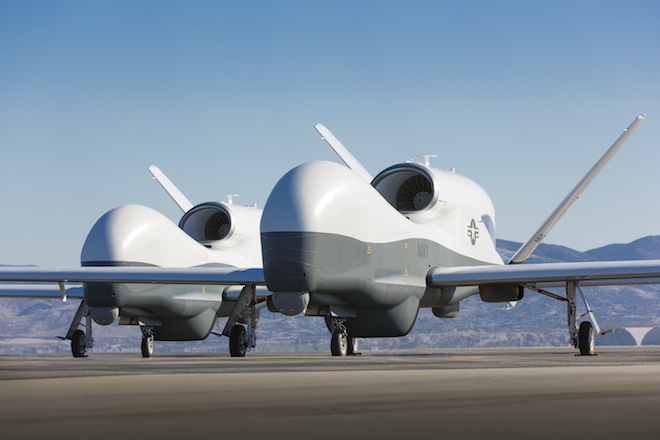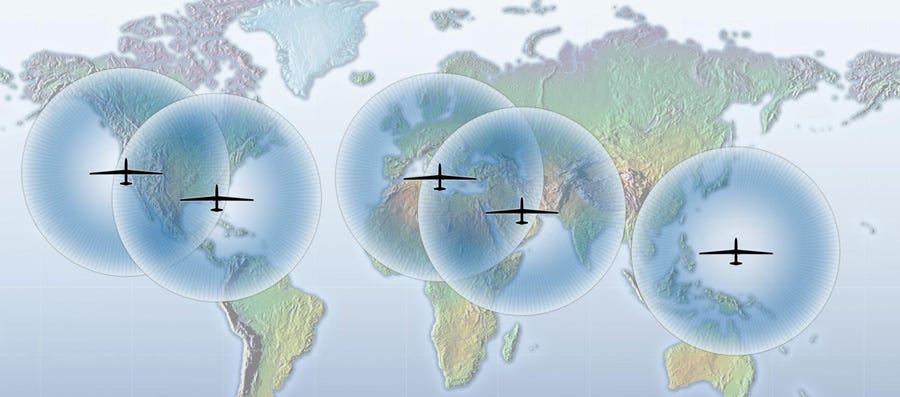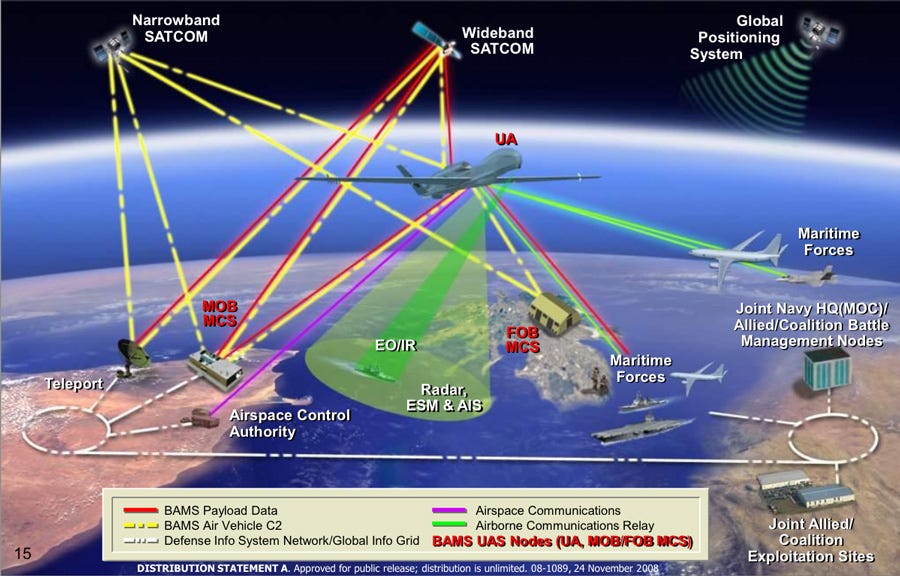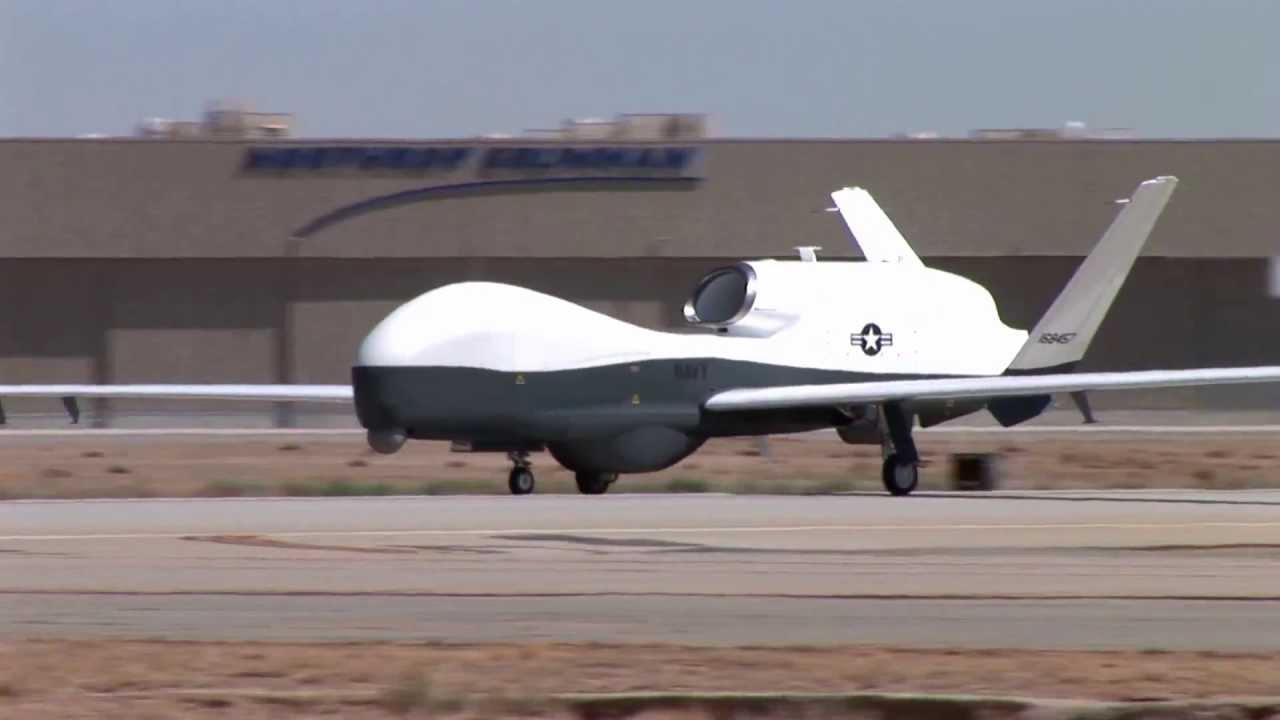The SC
ELITE MEMBER

- Joined
- Feb 13, 2012
- Messages
- 32,233
- Reaction score
- 21
- Country
- Location
The long-range maritime drone will give the U.S. unprecedented surveillance of the world's oceans.

For the U.S. Navy and Northrop Grumman, it's shaping up to be a banner year in unmanned flight. While the carrier-based autonomous X-47B continues to hit milestones aboard the USS George H.W. Bush somewhere off the East Coast, out west in Palmdale, Calif., today the Navy flew its MQ-4C Triton maritime drone for the first time, marking the beginning of a sea change (pardon the pun) in the way the U.S. military patrols the oceans. The drone flew for 80 minutes and reached an altitude of 20,000 feet.
The Triton isn't a completely new platform. If it looks familiar, that's because everyone from the U.S. Air Force to NASA has been using its cousin--Northrop Grumman's reliable Global Hawk--for years now, for intelligence, surveillance, reconnaissance, environmental monitoring, and meteorological data gathering, among other things. Triton is essentially an upgrade of the Global Hawk, optimized for maritime environments, with a strengthened airframe and de-icing features that allow it to rapidly ascend to and descend from high altitudes.
Those upgrades allow Triton to fly at altitudes nearly ten miles above sea level (its ceiling is listed as 60,000 feet, though it will likely stick to the 53,000-55,000 for most missions) for 24 hours at a time. That high vantage point allows its advanced sensors to take in a 2,000-nautical-mile view of the ocean in every direction. Carrying the Broad Area Maritime Surveillance (BAMS) sensor package (Popular Science awarded BAMS a Best of What's New award last year) along with a classified advanced radar system, Triton will be able to both detect and identify ships on the water.
That is, rather than registering as a simple blip on the radar screen, BAMS will be able to generate a picture of the shape of the ship and use that to identify it by profile. In that way, it will be able to tell a container ship from a Chinese frigate from a surfacing Russian submarine--from up to 2,000 nautical miles away (we felt that point was worth stressing here). Triton's strengthened airframe, augmented with de-icing technology, will then allow it to rapidly descend and ascend, so it can swoop in for a closer look at vessels of particular interest.
That's if everything works as advertised, and both Triton and BAMS are still in the early stages of development. The first flight by Triton is a big step forward. Though it's built on the back of the tested Global Hawk platform, the tweaks that have been made to the design are significant. In fact, a Global Hawk lent to the Navy by the Air Force for testing crashed at Naval Air Station Pax River last year--an event that was seen at the time as a potential setback for Triton and BAMS. So today's first flight is significant, as it marks the first airborne tests of a Triton and the beginning of the shift toward a brand new maritime capability.
That new capability is also quite significant. The Navy wants 68 Tritons based at five locations around the globe. Flying in rotations, they will be able to keep unprecedented tabs on the world's critical sea lanes and important littorals, working alongside and supporting the manned P-8A Poseidon mission (the Poseidon is replacing the P-3 Orion anti-sub warfare aircraft; basically the Triton, which is unarmed, will conduct the ISR and the Poseidon will handle any kinetic strikes or electronic warfare, should it be necessary). And because the Triton is unmanned and autonomous, it will require less intensive human labor to fly as well as less risk to human pilots.
"When operational, the MQ-4C will complement our manned P-8 because it can fly for long periods, transmit its information in real-time to units in the air and on ground, as well as use less resources than previous surveillance aircraft," said Rear Adm. Sean Buck, Patrol and Reconnaissance Group commander, in a statement. "Triton will bring an unprecedented ISR capability to the warfighter."
That's still a few years away, but today marks a critical step for the maritime capability, and a second huge leap forward for autonomous flight in just more than a week.
Navy Completes Flight Of MQ-4C Triton Spy Drone | Popular Science
http://www.popsci.com/technology/ar...t-of-gamechanging-mq4c-triton-spy-drone-video

These are the 5 main operating bases where the MQ-4C fleet will be used, networking with other Navy and Air Force drones — notice the South China Sea region ...

Northrop Grumman, U.S. Navy unveil MQ-4C Triton

The Navy could fly the all-seeing MQ-C4 like a big brother over strike fighters — like the F-35 — heading into combat. The surveillance drone would keep everyone in the loop.

Australia has committed to purchasing the US Navy's MQ-4C Triton unmanned aircraft



Triton drone surveillance fleet to be based at Edinburgh air force base in Adelaide (ABC News). Australia today announced it will buy unmanned surveillance ...


For the U.S. Navy and Northrop Grumman, it's shaping up to be a banner year in unmanned flight. While the carrier-based autonomous X-47B continues to hit milestones aboard the USS George H.W. Bush somewhere off the East Coast, out west in Palmdale, Calif., today the Navy flew its MQ-4C Triton maritime drone for the first time, marking the beginning of a sea change (pardon the pun) in the way the U.S. military patrols the oceans. The drone flew for 80 minutes and reached an altitude of 20,000 feet.
The Triton isn't a completely new platform. If it looks familiar, that's because everyone from the U.S. Air Force to NASA has been using its cousin--Northrop Grumman's reliable Global Hawk--for years now, for intelligence, surveillance, reconnaissance, environmental monitoring, and meteorological data gathering, among other things. Triton is essentially an upgrade of the Global Hawk, optimized for maritime environments, with a strengthened airframe and de-icing features that allow it to rapidly ascend to and descend from high altitudes.
Those upgrades allow Triton to fly at altitudes nearly ten miles above sea level (its ceiling is listed as 60,000 feet, though it will likely stick to the 53,000-55,000 for most missions) for 24 hours at a time. That high vantage point allows its advanced sensors to take in a 2,000-nautical-mile view of the ocean in every direction. Carrying the Broad Area Maritime Surveillance (BAMS) sensor package (Popular Science awarded BAMS a Best of What's New award last year) along with a classified advanced radar system, Triton will be able to both detect and identify ships on the water.
That is, rather than registering as a simple blip on the radar screen, BAMS will be able to generate a picture of the shape of the ship and use that to identify it by profile. In that way, it will be able to tell a container ship from a Chinese frigate from a surfacing Russian submarine--from up to 2,000 nautical miles away (we felt that point was worth stressing here). Triton's strengthened airframe, augmented with de-icing technology, will then allow it to rapidly descend and ascend, so it can swoop in for a closer look at vessels of particular interest.
That's if everything works as advertised, and both Triton and BAMS are still in the early stages of development. The first flight by Triton is a big step forward. Though it's built on the back of the tested Global Hawk platform, the tweaks that have been made to the design are significant. In fact, a Global Hawk lent to the Navy by the Air Force for testing crashed at Naval Air Station Pax River last year--an event that was seen at the time as a potential setback for Triton and BAMS. So today's first flight is significant, as it marks the first airborne tests of a Triton and the beginning of the shift toward a brand new maritime capability.
That new capability is also quite significant. The Navy wants 68 Tritons based at five locations around the globe. Flying in rotations, they will be able to keep unprecedented tabs on the world's critical sea lanes and important littorals, working alongside and supporting the manned P-8A Poseidon mission (the Poseidon is replacing the P-3 Orion anti-sub warfare aircraft; basically the Triton, which is unarmed, will conduct the ISR and the Poseidon will handle any kinetic strikes or electronic warfare, should it be necessary). And because the Triton is unmanned and autonomous, it will require less intensive human labor to fly as well as less risk to human pilots.
"When operational, the MQ-4C will complement our manned P-8 because it can fly for long periods, transmit its information in real-time to units in the air and on ground, as well as use less resources than previous surveillance aircraft," said Rear Adm. Sean Buck, Patrol and Reconnaissance Group commander, in a statement. "Triton will bring an unprecedented ISR capability to the warfighter."
That's still a few years away, but today marks a critical step for the maritime capability, and a second huge leap forward for autonomous flight in just more than a week.
Navy Completes Flight Of MQ-4C Triton Spy Drone | Popular Science
http://www.popsci.com/technology/ar...t-of-gamechanging-mq4c-triton-spy-drone-video

These are the 5 main operating bases where the MQ-4C fleet will be used, networking with other Navy and Air Force drones — notice the South China Sea region ...

Northrop Grumman, U.S. Navy unveil MQ-4C Triton

The Navy could fly the all-seeing MQ-C4 like a big brother over strike fighters — like the F-35 — heading into combat. The surveillance drone would keep everyone in the loop.

Australia has committed to purchasing the US Navy's MQ-4C Triton unmanned aircraft



Triton drone surveillance fleet to be based at Edinburgh air force base in Adelaide (ABC News). Australia today announced it will buy unmanned surveillance ...














